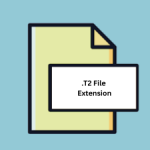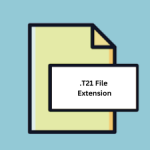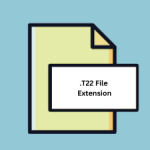.GRADE File Extension

GradeStat Document
| Developer | GradeStat |
| Popularity | |
| Category | Data Files |
| Format | .GRADE |
| Cross Platform | Update Soon |
What is an GRADE file?
The .GRADE file extension is associated with a specialized file format used predominantly in educational and grading software applications.
These files serve as repositories for various types of grading-related data, such as student scores, assessment results, and grading rubrics.
.GRADE files play a crucial role in the realm of education, facilitating the efficient management of grading data and aiding educators in assessing and evaluating students’ performance.
More Information.
The history of .GRADE files are closely intertwined with the evolution of educational technology. These files were initially conceptualized as a means to streamline grading operations and enhance the organization of student-related data.
Recognizing the need for a standardized file format to facilitate seamless data exchange, educational institutions and software developers embraced the concept of .GRADE files.
The primary purpose of .GRADE files, in their early days, were to provide educators with a convenient mechanism for storing and sharing grading data.
These files were crafted to encompass a wide array of information, ranging from individual student scores and assignment details to comprehensive grading rubrics.
This design aimed to simplify the process of evaluating student performance while ensuring consistency in grading practices.
Origin Of This File.
The origin of the .GRADE file extension can be traced back to the development of educational software and grading systems.
These files were specifically designed to house and manage data relevant to student assessments and grading processes, making them indispensable tools for educators and educational institutions.
While the precise originator of the .GRADE file format remains undisclosed, it has found widespread use in various educational software applications.
File Structure Technical Specification.
To effectively work with .GRADE files, understanding their file structure and technical specifications is paramount.
.GRADE files are typically binary in nature, which means they do not present human-readable content when opened in standard text editors.
Instead, they contain structured data organized in a specific format, which can be comprehended by compatible software applications.
The precise technical specifications of .GRADE files may vary depending on the software responsible for generating them.
Nevertheless, common elements are consistently found within .GRADE files encompass:
- Student Information: This section stores details regarding individual students, including their names, identification numbers, and contact information.
- Assignment Data: Information about assignments, such as assignment names, due dates, and corresponding scores, is housed within this section.
- Grading Rubrics: .GRADE files often incorporate grading rubrics or predefined criteria employed for evaluating student work.
- Course Information: Vital information related to the course itself, encompassing elements such as the course name, course code, and instructor details, is stored within this section.
- Timestamps: .GRADE files may include timestamps to record key events, such as when assessments were conducted or when grading data was updated.
- Comments and Feedback: Instructors frequently include comments and feedback specific to individual students within .GRADE files, facilitating effective communication.
- Metadata: Various metadata components, including file version details and information about the file’s creator, may be embedded within .GRADE files.
How to Convert the File?
Converting .GRADE files may be essential when the need arises to employ the data in alternative formats or with software that does not inherently support this file type.
Below are the steps for converting .GRADE files:
- Utilizing Compatible Software: The most straightforward approach for converting .GRADE files is to employ the educational software or grading application that initially generated them. Most such applications offer export functionalities to save data in universally accepted file formats like CSV or Excel.
- Third-Party Conversion Tools: Some third-party file conversion tools may be available that can effectively convert .GRADE files into more widely recognized formats. It is imperative to ensure the reliability and security of such conversion tools before use.
- Manual Extraction (Advanced Users): For proficient users with a deep understanding of file formats, there is the possibility of manually extracting data from .GRADE files by accessing the binary structure. This method is not recommended for non-technical users and carries the risk of data corruption.
Advantages And Disadvantages.
Advantages:
- Efficiency: .GRADE files contribute to the streamlining of grading procedures, allowing educators to manage student-related data more efficiently and accurately.
- Structured Data: These files employ a structured format that facilitates the organization and analysis of grading information, ensuring consistency and coherence.
- Compatibility: A multitude of educational software applications readily support .GRADE files, thereby guaranteeing compatibility across diverse platforms and systems.
- Security: .GRADE files can be safeguarded through password protection or encryption, assuring the confidentiality and security of sensitive grading data.
Disadvantages:
- Proprietary Format: .GRADE files are frequently associated with specific software applications, limiting their interoperability with alternative systems and software.
- Learning Curve: Users unfamiliar with the particular software used for creating .GRADE files may encounter a steep learning curve, necessitating time and effort to adapt effectively.
- Risk of Data Loss: Incompatibility issues or changes in the software ecosystem can introduce risks of data loss or file corruption, potentially compromising the integrity of grading records.
How to Open GRADE?
Open In Windows
- Employ Compatible Software: If you possess a .GRADE file, the most straightforward approach is to open it using the educational software or grading application that generated it.
- Investigate Third-Party Tools: Investigate whether there are any third-party software applications capable of opening .GRADE files or offering conversion options. Ensure the credibility and safety of such tools.
Open In Linux
- Wine Compatibility Layer: On Linux, consider utilizing the Wine compatibility layer. Wine allows you to run Windows applications on a Linux environment, potentially enabling access to .GRADE files through compatible applications. However, compatibility may fluctuate.
Open In MAC
- Virtualization Software: Similar to Linux, Mac users can leverage virtualization software such as Parallels or VirtualBox to run Windows-based educational software, thereby gaining access to .GRADE files via compatible applications.
Open In Android
- Install Mobile Apps: If Android versions of the educational software that creates .GRADE files are available, you can install these apps on your Android device to open and work with .GRADE files.
Open In IOS
- Seek iOS Apps: Explore the possibility of iOS versions of the educational software capable of handling .GRADE files. By installing these apps on your iOS device, you can access and view .GRADE files seamlessly.













